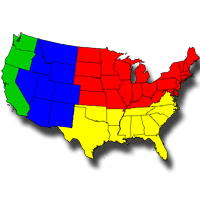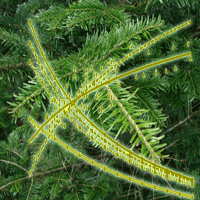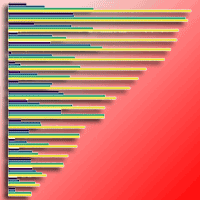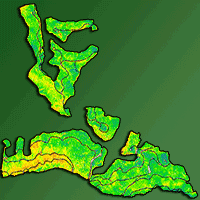
Spatial distribution of aboveground biomass stock in tropical dry forest in Brazil
Héveli Kalini Viana Santos (1), Robson Borges De Lima (2) , Rafael Lucas Figueiredo De Souza (3), Domingos Cardoso (4), Peter W Moonlight (5), Thaine Teixeira Silva (1), Cinthia Pereira De Oliveira (2), Francisco Tarcísio Alves Júnior (2), Elmar Veenendaal (6), Luciano Paganucci De Queiroz (7), Priscyla MS Rodrigues (8), Rubens Manoel Dos Santos (9), Tiina Sarkinen (10), Alessandro De Paula (1), Patrícia Anjos Bittencourt Barreto-Garcia (1), Toby Pennington (11), Oliver L Phillips (12)
iForest - Biogeosciences and Forestry, Volume 16, Issue 2, Pages 116-126 (2023)
doi: https://doi.org/10.3832/ifor4104-016
Published: Apr 17, 2023 - Copyright © 2023 SISEF
Research Articles
Abstract
Climate change is being intensified by anthropogenic emission of greenhouse gasses, highlighting the value of forests for carbon dioxide storing carbon in their biomass. Seasonally dry tropical forests are a neglected, threatened, but potentially critical biome for helping mitigate climate change. In South America, knowing the amount and distribution of carbon in Caatinga seasonally dry vegetation is essential to understand its contribution to the global carbon cycle and subsequently design a strategic plan for its conservation. The present study aimed to model and map the spatial distribution of the potential forest biomass stock across 32 forest fragments of Caatinga, in the state of Bahia, Brazil, using regression kriging and Inverse Square of Distance techniques, building from point measurements of vegetation biomass made on-the-ground in ecological plots. First, a model for estimating biomass was fitted as a function of environmental variables to apply regression kriging, and then applied to the maps of the selected components. Elevation, temperature, and precipitation explained 46% of the biomass variations in the Caatinga. The model residuals showed strong spatial dependence and were mapped based on geostatistical criteria, selecting the spherical semivariogram model for interpolation by ordinary kriging. Biomass was also mapped by the Inverse Square of Distance approach. The quality of the regression model suggests that there is good potential for estimating biomass here from environmental variables. The regression kriging showed greater detail in the spatial distribution and revealed a spatial trend of increasing biomass from the north to south of the domain. Additional studies with greater sampling intensity and the use of other explanatory variables are suggested to improve the model, as well as to maximize the technique’s ability to capture the actual biomass behavior in this newly studied seasonally dry ecosystem.
Keywords
Geostatistics, Regression Kriging, Spatial Analysis, Forest Inventory
Authors’ Info
Authors’ address
Thaine Teixeira Silva 0000-0001-6082-371X
Alessandro De Paula 0000-0003-3676-3846
Patrícia Anjos Bittencourt Barreto-Garcia 0000-0002-8559-2927
Universidade Estadual do Sudoeste da Bahia, Departamento de Ciências Florestais, 45031-900 Vitória da Conquista, BA (Brazil)
Cinthia Pereira De Oliveira
Francisco Tarcísio Alves Júnior
Universidade do Estado do Amapá, Departamento de Engenharia Florestal, 68900-070 Macapá, AP (Brazil)
Universidade de São Paulo, Escola Superior de Agricultura Luiz de Queiroz, 13418-900, Piracicaba, SP (Brazil)
Instituto de Biologia, Universidade Federal da Bahia, 40.026-010, Salvador, BA (Brazil)
Tropical Diversity Section, Royal Botanic Garden Edinburgh, EH3 5NZ, Edinburgh (United Kingdom)
Wageningen University, Plant Ecology and Nature Conservation Group, 6700 AK, Wageningen (Netherlands)
Departamento de Ciências Biológicas, Universidade Estadual de Feira de Santana, 440369-00, Feira de Santana, BA (Brazil)
Colegiado de Ecologia, Universidade Federal do Vale do São Francisco, 563049-17, Senhor do Bonfim, BA (Brazil)
Universidade Federal de Lavras, 37200-900, Lavras, MG (Brazil)
Tropical Diversity Section, Royal Botanic Garden Edinburgh, EH3 5NZ, Edinburgh (United Kingdom)
School of Geography, University of Leeds, LS2 9JT, Leeds (United Kingdom)
Corresponding author
Paper Info
Citation
Viana Santos HK, Borges De Lima R, Figueiredo De Souza RL, Cardoso D, Moonlight PW, Teixeira Silva T, Pereira De Oliveira C, Alves Júnior FT, Veenendaal E, Paganucci De Queiroz L, Rodrigues PMS, Dos Santos RM, Sarkinen T, De Paula A, Barreto-Garcia PAB, Pennington T, Phillips OL (2023). Spatial distribution of aboveground biomass stock in tropical dry forest in Brazil. iForest 16: 116-126. - doi: 10.3832/ifor4104-016
Academic Editor
Emanuele Lingua
Paper history
Received: Mar 24, 2022
Accepted: Feb 14, 2023
First online: Apr 17, 2023
Publication Date: Apr 30, 2023
Publication Time: 2.07 months
Copyright Information
© SISEF - The Italian Society of Silviculture and Forest Ecology 2023
Open Access
This article is distributed under the terms of the Creative Commons Attribution-Non Commercial 4.0 International (https://creativecommons.org/licenses/by-nc/4.0/), which permits unrestricted use, distribution, and reproduction in any medium, provided you give appropriate credit to the original author(s) and the source, provide a link to the Creative Commons license, and indicate if changes were made.
Web Metrics
Breakdown by View Type
Article Usage
Total Article Views: 25774
(from publication date up to now)
Breakdown by View Type
HTML Page Views: 19679
Abstract Page Views: 3643
PDF Downloads: 2054
Citation/Reference Downloads: 6
XML Downloads: 392
Web Metrics
Days since publication: 959
Overall contacts: 25774
Avg. contacts per week: 188.13
Citation Metrics
Article Citations
Article citations are based on data periodically collected from the Clarivate Web of Science web site
(last update: Mar 2025)
Total number of cites (since 2023): 1
Average cites per year: 0.33
Publication Metrics
by Dimensions ©
Articles citing this article
List of the papers citing this article based on CrossRef Cited-by.
References
Adaptation of the century model to simulate C and N dynamics of Caatinga dry forest before and after deforestation. Agriculture, Ecosystems and Environment 254: 26-34.
CrossRef | Gscholar
Desempenho da estratificação em um fragmento de cerrado stricto sensu utilizando interpolador geoestatístico [Stratification performance in a cerrado stricto sensu fragment using geostatistical interpolator]. Cerne 18 (4): 675-681.
CrossRef | Gscholar
Mapping tree density at a global scale. Nature 525: 201-205.
CrossRef | Gscholar
Diversity and evolution of flowering plants of the Caatinga domain. In: “Caatinga: The Largest Tropical Dry Forest Region in South America” (JMC da Silva, IR Leal, M Tabarelli eds). Springer International Publishing, Cham, Switzerland, pp. 23-63.
CrossRef | Gscholar
Plant diversity patterns in neotropical dry forests and their conservation implications. Science 353: 1383-1387.
CrossRef | Gscholar
ArcGIS Desktop, version 10.8. Environmental Systems Research Institute, Redlands, CA, USA.
Gscholar
Caatinga: estratégias de conservação [Caatinga: conservation strategies]. Estudo Técnico, Consultoria legislativa, Brazil, pp. 105.
Gscholar
SoilGrids250m: Global gridded soil information based on machine learning. PLoS One. 12: e0169748.
CrossRef | Gscholar
Mapeamento de recurso naturais do Brasil Escala 1:250.000. Pedologia Versão 2021 [Mapping of natural resources in Brazil Scale 1:250.000. Pedology Version 2021]. Brazilian Institute for Geography and Statistics, Coordenação de Recursos Naturais e Estudos ambientais, Rio de Janeiro, RJ, Brazil.
Online | Gscholar
Estimativa de biomassa lenhosa da caatinga com uso de equações alométricas e índices de vegetação [Estimation of woody biomass of the caatinga using allometric equations and vegetation indices]. Scientia Forestalis 42 (102): 289-298.
Online | Gscholar
Solos do Nordeste [Northeast soils]. Embrapa Solos, Recife, PE, Brazil, pp. 8.
Gscholar
Análise estatística e geoestatística da precipitação média para o município de Joinville (SC) [Statistical and geostatistical analysis of average precipitation for the municipality of Joinville (SC)]. Revista Brasileira de Meteorologia 31 (2): 229-239.
CrossRef | Gscholar
Expanding tropical forest monitoring into dry forests: the DRYFLOR protocol for permanent plots. Plants, People, Planet 3: 295-300.
CrossRef | Gscholar
Dinâmica temporal e aspectos da vegetação em uma comunidade de Caatinga [Temporal dynamics and vegetation aspects in a Caatinga community]. MSc Thesis, Universidade Federal de Sergipe, São Cristóvão, SE, Brazil, pp. 98.
Gscholar
Biomass resilience of neotropical secondary forests. Nature 530: 211-214.
CrossRef | Gscholar
Benchmark map of forest carbon stocks in tropical regions across three continents. Proceedings of the National Academy of Sciences USA 108: 9899-9904.
CrossRef | Gscholar
Estoques de volume, biomassa e carbono na madeira de espécies da Caatinga em Caicó, RN [Volume, biomass and carbon stocks in wood from Caatinga species in Caicó, RN]. Pesquisa Florestal Brasileira 36 (85): 1-7.
CrossRef | Gscholar
Pre-stratified modelling plus residuals kriging reduces the uncertainty of aboveground biomass estimation and spatial distribution in heterogeneous savannas and forest environments. Forest Ecology and Management 445: 96-109.
CrossRef | Gscholar
Environmental correlates for tropical tree diversity and distribution patterns in Borneo. Diversity and Distributions 15: 523-532.
CrossRef | Gscholar

















